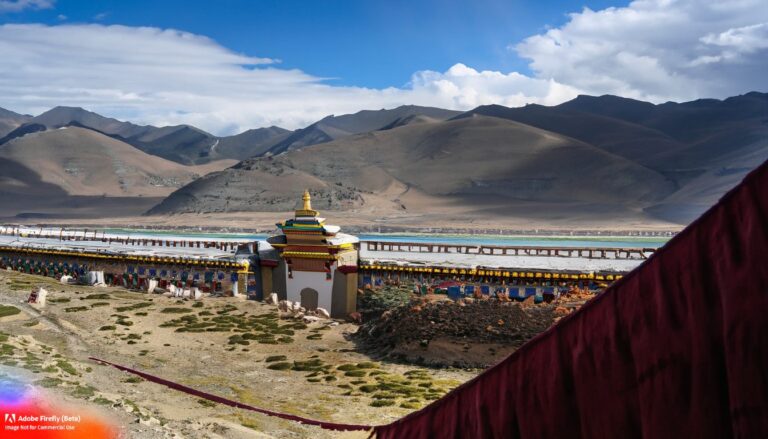
Tibet is known for its abundance of lakes, and there are several factors that contribute to the region’s high number of lakes.
Here are some reasons why Tibet has so many lakes:
- Geological Formation: Tibet is located on the Tibetan Plateau, often referred to as the “Roof of the World.” The unique geological processes, including tectonic movements and the collision of the Indian and Eurasian plates, have resulted in the formation of numerous lakes in the region.
- Glacial Activity: Tibet is home to numerous glaciers, which are a significant source of freshwater for the lakes. As glaciers melt, they give rise to glacial lakes, contributing to the overall lake density in Tibet.
- High Altitude: Tibet is characterized by its high altitude, with much of the region situated at an elevation above 4,000 meters (13,000 feet). The high altitude, coupled with the surrounding mountain ranges, creates favorable conditions for the accumulation of water in the form of lakes.
- Rainfall and Snowmelt: Despite being a relatively arid region, Tibet still receives some precipitation in the form of rainfall and snow. The monsoon season brings moisture from the Indian Ocean, resulting in increased rainfall and subsequent filling of lakes. Additionally, the melting of snow during warmer months contributes to the water sources that feed the lakes.
- Permafrost: The Tibetan Plateau experiences permafrost, which is permanently frozen ground. The presence of permafrost helps to retain water in the region, resulting in the formation and maintenance of lakes.
- Volcanic Activity: Tibet has a history of volcanic activity, and volcanic eruptions can lead to the formation of crater lakes. These volcanic lakes add to the diversity of Tibet’s lake system.
- Natural Depressions and Basins: The topography of Tibet includes numerous natural depressions and basins that have acted as natural reservoirs for collecting water over time. These basins provide favorable conditions for the formation and retention of lakes.
- Cultural and Spiritual Significance: Lakes hold great cultural and spiritual significance in Tibetan culture. Many lakes are considered sacred, and they are often associated with religious practices and rituals. This cultural reverence for lakes has contributed to their preservation and protection.
Tibet is home to numerous breathtaking lakes, known for their scenic beauty and cultural significance.

Here are some of the famous lakes in Tibet:
- Lake Namtso: Located at an elevation of 4,718 meters (15,479 feet), Lake Namtso is one of the highest saltwater lakes in the world. It is renowned for its stunning turquoise color and breathtaking mountain views. The lake holds great spiritual importance for Tibetans and is a popular pilgrimage site.
- Lake Yamdrok: Also known as Yamdrok Yumtso, this sacred lake is located at an altitude of 4,441 meters (14,570 feet). It is famous for its deep blue color and its surrounding snow-capped mountains. Lake Yamdrok is considered one of the four holy lakes of Tibet and holds great religious significance.
- Lake Manasarovar: Situated at an elevation of 4,590 meters (15,060 feet), Lake Manasarovar is another sacred lake in Tibet. It is one of the highest freshwater lakes in the world and is associated with Hinduism, Buddhism, and Jainism. Pilgrims from various religious backgrounds visit the lake to cleanse their sins and seek spiritual enlightenment.
- Lake Puma Yumco: Located in the western part of Tibet, Lake Puma Yumco is a stunning freshwater lake surrounded by snow-capped mountains. It is known for its tranquil atmosphere and picturesque beauty. The lake is considered sacred by Tibetans and is associated with many legends and myths.
- Lake Lhamo La-tso: Situated in the southeastern part of Tibet, Lake Lhamo La-tso is revered as a sacred oracle lake. It is believed to possess prophetic powers, and Tibetan spiritual leaders visit the lake to seek visions and guidance. The picturesque surroundings and the cultural significance make it a popular destination for tourists and pilgrims.
- Lake Basum Tso: Located in Nyingchi Prefecture, Lake Basum Tso is known for its crystal-clear waters, lush green surroundings, and stunning reflections of the surrounding mountains. It is considered a hidden gem of Tibet and offers a peaceful retreat amidst nature.
- Lake Gyantso: Situated in the northern part of Tibet, Lake Gyantso is a saltwater lake known for its vast expanse and unique geological formations. The lake attracts visitors with its stark beauty and the opportunity to witness migratory birds.
Summary
It is the combination of these factors, including geological processes, glacial activity, high altitude, precipitation, permafrost, volcanic activity, natural depressions, and cultural significance, that contribute to the abundance of lakes in Tibet. These lakes not only add to the natural beauty of the region but also play crucial roles in the ecosystem and provide valuable resources for both humans and wildlife.
These are just a few examples of the famous lakes in Tibet. Each lake has its own unique charm, cultural significance, and natural beauty. Whether it’s the breathtaking colors, the serene atmosphere, or the spiritual aura, the lakes of Tibet are truly mesmerizing and worth exploring.






